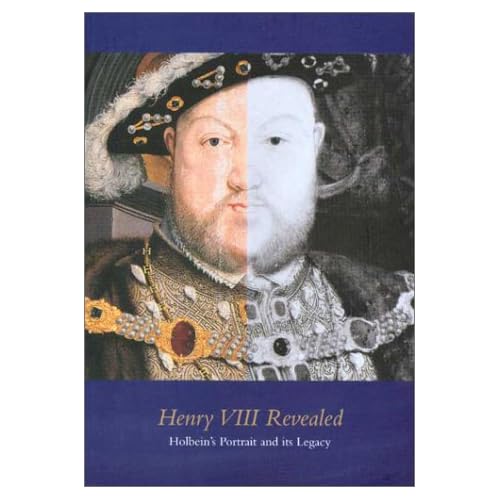Henry VIII Revealed: Holbein's Portrait and Its Legcy
Category: Books,Arts & Photography,History & Criticism
Henry VIII Revealed: Holbein's Portrait and Its Legcy Details
The portly figure of Henry VIII depicted by Holbein may be very familiar, but this book reveals much more about the portrait, the sitter, the artist, and his workshop. It gathers together and analyzes the several copies and variants of Holbein’s Whitehall cartoon of Henry VIII, more than one of which is by the only significant painter immediately after Holbein in England, Hans Eworth. The book reveals for the first time the results of extensive technical analysis and historical research undertaken on surviving versions of the portrait in the Walker Art Gallery, Chatsworth, Petworth, Trinity College, Cambridge, and elsewhere. It throws light not only on Henry VIII but on the Tudor court and on courtiers who, for their own purposes, wished to keep his memory alive after his death. The book explores how and when the portraits were painted and the motivation behind their production and also traces how they affected subsequent portrayals of the monarch, down to film and television. The book accompanies an important exhibition at the Walker Art Gallery, Liverpool, where Xanthe Brooke is curator and David Crombie painting conservator.

Reviews
Many people don't know it but Hans Holbein the Younger, who was Henry VIII's formal court portraitist, almost lost his head over Anne of Cleves. No, not falling in love...like Anne Boleyn and Katherine Howard, Henry might have had Holbein beheaded for the grievous error of deceiving Henry to believe she was more attractive than she was. Henry thought he'd be meeting a fair woman. He created a magnificent company to march with him on horseback to greet her. As soon as he got close enough to see her face, he blanched but then yelled: "My sister!!!" By this he meant: "you're of royal blood but I ain't gonna hook up with you." Holbein steered clear because, to save face and to keep the "Flanders Mare" at bay, the mercurial Henry had to give her Hever Castle as a pay-off for not marrying her. Ironically, Hever was Anne Boleyn's childhood home.Another fact about Hans Holbein that is discussed in this book briefly is that he is the best source of information on the intricacy of oriental carpets and the embroidery on clothing which were so important to the Tudors. In a pile "Persian" carpet, there can 1,200 knots per square inch. It is stated in this book that researchers could determine which of the various forms of knots the carpets held. The embroidery was a key part of dress: particularly with Henry VIII and Elizabeth I, the nobility had to vie with each other for the most magnificent designs and expensive materials. Henry's upper tunic and sleeves in this portrait--and you can see it on the cover--are covered with puffs of white cloth that are pulled out from under the boldly embroidered fabric. The stitching on these items is intricate and quite time-consuming as it was not just a mass of lines and rows but intricate knotwork like you see in Celtic art. Holbein took such care to be detailed here that even though no clothes from Henry are extant, we know precisely how richly he dressed. In fact, Holbein was so brilliant at depicting each little stitch, this embroidery known as blackwork and double-running stitch has been dubbed the Holbein stitch. Among thousands of different stitches in needlework, very few are named after one person.I got this reviewed book because I just finished reading Xanthe Brook's:The Lady Lever Art Gallery: Catalogue of EmbroideriesSee as how she is an expert historian of needlework, I'm a little surprised she hasn't touched more upon this in this book. That being said: you are either a lover of portraiture or Henry VIII. So you want to know what's inside. Well, I can't think of any possible aspect of these paintings (you know there are more than one, right?) that is not discussed in excruciating detail. It is really glorious to read of the history of the paintings: who commissioned them, where were they painted, how were they painted, why were they painted. All these elements are gracefully explained. I like to learn of the nuts and bolts analysis of the very pigments, strokes of both drawing and painting, and the layers of wood upon which these appeared. On page 97, one of the pearls in Henry's neck chain is pictured in such close-up--it's 3/4"--that you can see the minute crackling of the paint with age. Once you peruse the chapters to whatever depth you like, you're treated in the back of the book with two fold-out pages; these display Plates 1-7 where a full-size portrait covers the entire page. You can see all of Plates 1-3 when you fold out the first page and then 4-7 at the same time when you fold out the second page. By flipping these pages back and forth, your eyes fly over the drawing which is in the National Portrait Gallery, the Trinity College, Cambridge portrait, the Petworth House portrait and FOUR portraits from the Walker House in Liverpool. These latter four show the painting from before, during and after the painting was restored as you can see clearly on the cover of the book.I know this is probably all minutia to just about everyone but since you can get this fascinating book for less than a dollar, if you have any interest in art or the Tudors, this is an excellent bargain.


